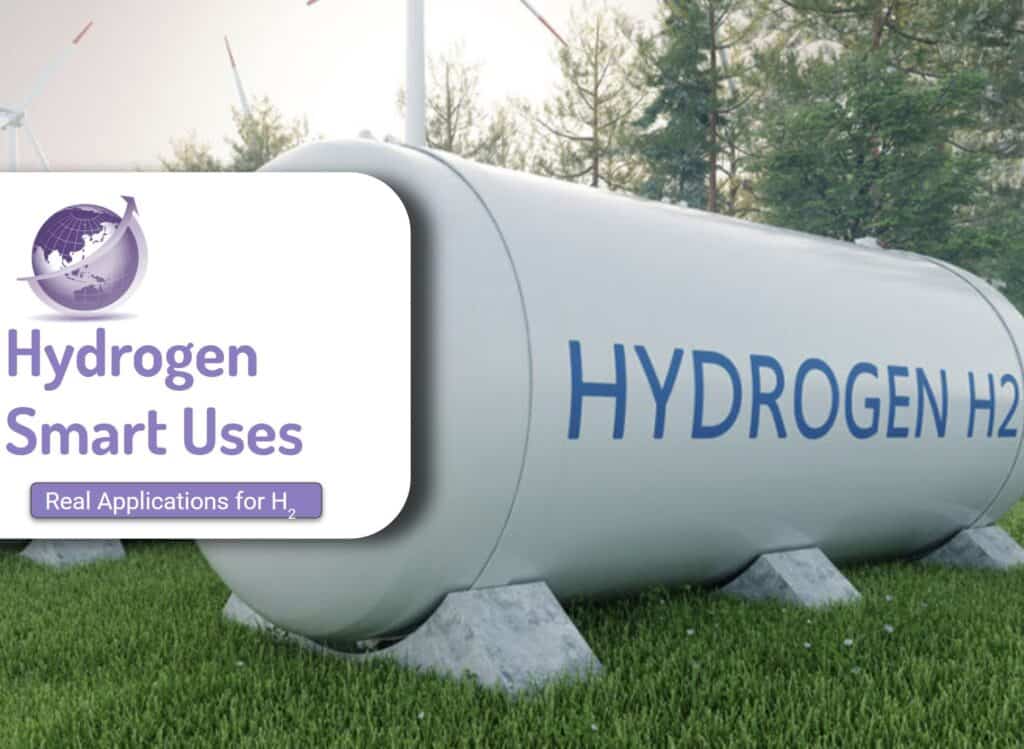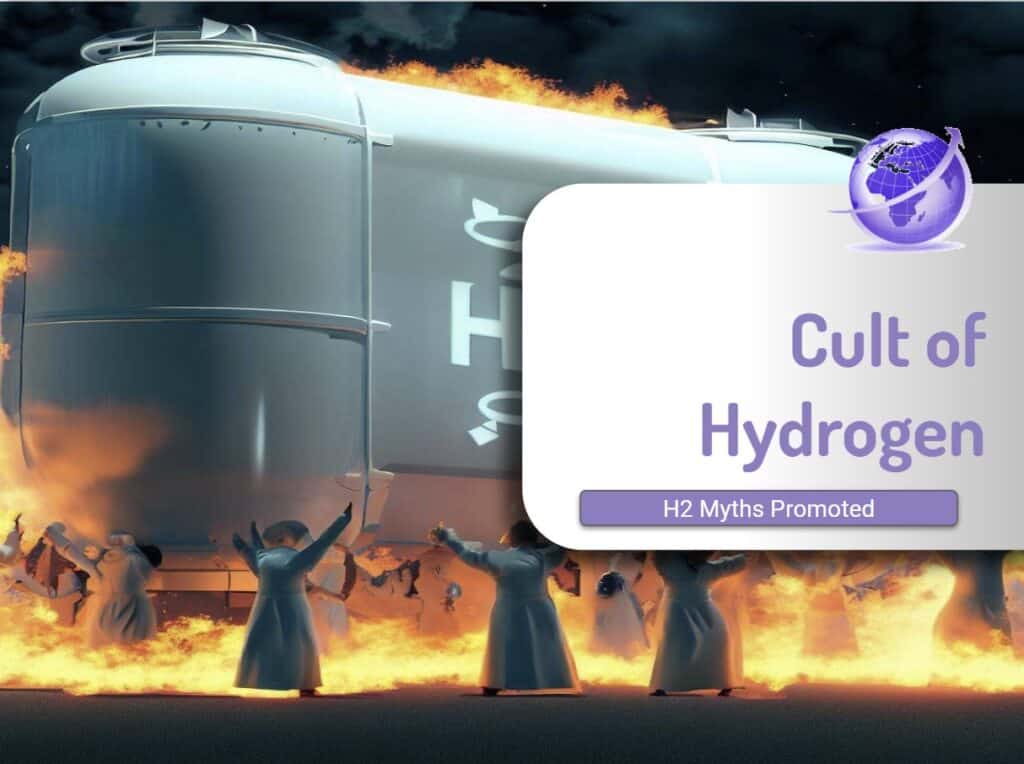There is a good deal of enthusiasm for hydrogen for green steel but there are hydrogen storage and transport problems. These hydrogen myths are defined in detail in a CleanTechnica Podcast with Paul Martin from the Hydrogen Science Coalition. An article by Michael Liebriech in Dec 2022 “The Unbearable Lightness of Hydrogen” explains the challenges in detail.
As a chemical feedstock, of course, hydrogen is irreplaceable. However, as an energy storage medium, it has only a 50% round-trip efficiency – far worse than batteries. Fuel cells, turbines and engines are only 60% efficient – far worse than electric motors . They are far more complex. As a source of heat, hydrogen costs four times as much as natural gas. As a way of transporting energy, hydrogen pipelines cost three times as much as power lines, and ships and trucks are even worse. And that ignores hydrogen makes for good bombs.
Multiple Losses in Storage and Transport
With multiple dnd-to-end losses of natural gas vs hydrogen across transmission and distribution, hydrogen has some serious challenges. These are often glossed over but are really difficult challenges.
Loss in Transport
- Much modern piping is polyethylene, replacing cast iron pipes which constantly break. While it has advantages, hydrogen diffuses through polyethylene without any cracks at all. That means that we can’t reuse existing piping in many, many cases, a fundamental disconnect on claims of reuse of infrastructure assets by natural gas utilities. Some gas reticulation systems are ok.
- Hydrogen boil-offs in shipping. When you have a gas stored as a liquid by keeping it cold at reasonable temperatures, the cryogenic liquid turns into gas with any heat coming in. With ammonia and LNG, you can run compression and cooling equipment and return it, as they are liquids at much higher temperatures than hydrogen with its 24° Kelvin boiling point. The way to deal with this is to create the biggest, spherical, vacuum-insulated tanks possible, but even so, the boil-off rate is 0.2% per day. Shipping hydrogen tanks ones are likely to be worse because they can’t be as big. At the scale of trucks, the surface area to volume ratio leads to 1% losses per day.
- Shipping hydrogen would be 5-7 times as expensive as shipping LNG as a result.
- Putting it into pipes and moving it requires 3 times the energy to compress and move the hydrogen, so all compressors would have to be replaced.
Loss in Storage
- This is true for hydrogen storage tanks at airports, where liquid hydrogen is the only option. Every airport would have to make hydrogen near the airport and have a hydrogen liquification facility at every airport. This eliminates economies of scale for centralized hydrogen manufacturing and liquification, making it even more expensive as an aviation fuel.
- Hydrogen has another pernicious problem, that of spin of the electrons in hydrogen atoms. Basically, they have different spins at different temperatures, and as you cool the hydrogen, it gives off heat due to changes in spin. When the first people made liquid hydrogen at 24° Kelvin, it turned back to gas the next day due to this problem. This means more equipment, energy, and expense.
- Liquifying hydrogen takes 3 times the energy as liquifying natural gas, then you lose 0.2% to 1% of the hydrogen per day due to boil-off.
Multiple losses in Homes
While there are multiple loss problems along the supply chain, homes are more problematic.
- We’ve had 100 years of experience making natural gas appliances safe in homes. There are no certified home appliances for hydrogen today. There is no jurisdiction with existing building codes that support hydrogen appliances.
- Building codes and approvals are a patchwork that vary by municipality, not by country. Every city would have to update its building codes and processes to allow hydrogen appliances, a massive regulatory burden.
- Hydrogen has a much wider explosive range than natural gas. The lower explosive limit of methane is 6% while hydrogen is 4%. The upper explosive limit of hydrogen is 75%, vastly higher than 15% with natural gas.
- This means that there is a much broader range of leaked hydrogen that will explode in homes. And hydrogen ignites with a third of the energy of natural gas as well. The odds of an explosion in buildings with hydrogen vs natural gas are much higher.
Odorants Problem
- Natural gas smells not because methane smells, but because we add odorants as a safety feature. (Gas made from coal had carbon monoxide and in the 1950s with the change to methane gas.
- The mercaptans we use in natural gas can’t be used with hydrogen because they react to it. While there are odorants that work with hydrogen, they cause fuel cells to fail.
- That means that two hydrogen distribution networks would be required, one for hydrogen appliances and one for fuel cells, and fuel cells would have to be outside of the home, not inside. The requirements for a hydrogen odorant are very high and there may not be one.
Politics
A major concern is public money going into this hydrogen research. If rich people and venture capitalists want to make very low probability bets, that’s their business. Otherwise public money that could be spent earnestly solving the decarbonization problem ends up being spent on the emperor’s new clothes instead. Australian politics in 2021 was “technology not taxes” which avoided taking action. Today, the hydrogen or #hopium epidemic are the missing clothes of the emperor. While there are individuals (such as Dr Andrew Forrest, who actually is earnest about hydrogen as a fuel, the fossil fuel industry isn’t earnest.
Hydrogen is a no-lose bet for the fossil fuel industry. Either they push hydrogen and it delays decarbonization and hence the fossil fuel industry wins, or the fossil fuel industry gets dragged into the future with tens of billions of public money for blue hydrogen, and they win.
Michael Liebreich BloombergNEF
Bunker fuels and asphalt for roads and roofing shingles are effectively waste products of petroleum refineries, residuum, so with the radical reduction in refining, we’ll have to find replacements for roads and roofs as well, while the shipping industry will have to refuel regardless.
Shipping Minerals and Hydrogen
- The cost of shipping per ton mile is 40%-60% fuel, even using the cheapest fossil fuels available, slow-sailing to conserve fuel, and treating the atmosphere and oceans as open sewers.
- Every fuel alternative is going to be more expensive.
- 40% of all shipping is oil, gas, and coal, so that’s going away.
Production of Steel from Iron Ore will Change
- 15% of shipping is raw iron ore
- With increased shipping costs, much more local processing of iron ore and other products will be done, so more finished, higher-value products will be shipped instead. This is what Fortescue Metals are intending with their green hydrogen.
- Cheap energy is a mask for poor organization. Absurd supply chains that jump all over the earth are coming to an end.
- A future where fossil CO2 emissions are expensive, recycling of materials will become more prevalent.
- Steel and aluminum are already among the most recycled materials in the world, and that will simply increase.
- Electric minimills near to the sources of scrap, powered by renewables, will radically reduce the shipping of steel and its constituents.
- Aluminum is easier to decarbonize than steel, so aluminum or wood will be used a lot more as a structural component.
- The direct electrolytic process for aluminum running on renewables has been around for 70 years. Some of the steps in aluminum which currently use fossil fuels can be replaced more easily than the blast furnace for steel.
Conclusion: Hiding Hydrogen Storage and Transport Problems
- Replacing black hydrogen with green hydrogen is ok.
- Blending hydrogen with fossil gas is bad.
- Hydrogen as a transportation fuel is both ineffective and inefficient.

Promising New Transport Technologies
As with many new technologies, research will find new ways. EAT gives the example of the world’s first hydrogen-shipping ship, the Suiso Frontier, a 116-meter (381-ft) cargo ship that can carry 88.5 tonnes of hydrogen, cryogenically cooled into a liquid state at great expense. The Si+ powder will weigh more, but it’ll also take up a ton less space. The same amount of hydrogen can effectively be carried in about 33 shipping containers full of Si+ powder, so a standard cargo ship’s ~10,000 container capacity represents the ability to carry ~30,000 tonnes of hydrogen – or 339 times more than the Suiso Frontier.
- A hydrogen transport powder promising double the density says New Atlas. Hong Kong company EPRO Advance Technology (EAT) says its Si+ powder offers an instant end to the difficulties of shipping and storing green energy. Stir this silicon-based powder into water, and hydrogen will bubble out, ready for immediate use. EAT’s silicon-based powder doesn’t require you to start off with any hydrogen at all – and getting the hydrogen back out is even easier. The Si+ powder can be made using a (preferably renewable) energy source, as well as metallurgical-grade silicon – which itself can be made from sand, or from crushed-up recycled solar panels and electronics. EAT’s process results in a porous silicon powder that’s completely safe and easy to transport. Si + 2H2O -> SiO2 + 2H2. The sand can be reused.
- Deakin University’s mechanochemical storage process takes hydrogen gas and traps it in a powder for easy, stable transport, releasing it only once the recyclable powder is heated, The team has demonstrated that grinding certain amounts of certain powders with precise pressure levels of certain gases can trigger a mechanochemical reaction that absorbs the gas into the powder and stores it there, giving you what’s essentially a solid-state storage medium that can hold the gases safely at room temperature until they’re needed. The gases can be released as required, by heating the powder up to a certain point.
- New Atlas reports on South Korean research. The team synthesized nanoporous magnesium borohydride (Mg(BH4)2), a framework with partially negatively-charged hydrogen atoms forming the nanopore’s inner surface, enabling the uptake of hydrogen and nitrogen.

Oh et al.
More Reading
- Ultra-high density hydrogen storage holds twice as much as liquid H2 https://newatlas.com/energy/high-density-hydrogen-storage









